

The Law of Success. The Law of Success (originally The Law of Success in 16 Lessons) is the title of Napoleon Hill’s first book set, published initially in 1928 as a multi-volume correspondence course and later more compact formats in recent years.
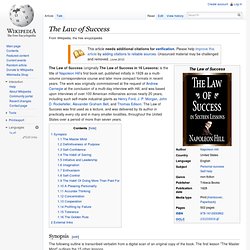
The work was originally commissioned at the request of Andrew Carnegie at the conclusion of a multi-day interview with Hill, and was based upon interviews of over 100 American millionaires across nearly 20 years, including such self-made industrial giants as Henry Ford, J. P. Morgan, John D. Scientific management - a history and criticism - Google eBookstore. Shop management - Google eBookstore. The best business books ever: the ... Joseph M. Juran. Early life[edit] Juran was born in Brăila, Romania, one of the six children born to a Jewish couple, Jakob and Gitel Juran; they later lived in Gura Humorului.

He had three sisters: Rebecca (nicknamed Betty), Minerva, who earned a doctoral degree and had a career in education, and Charlotte. He had two brothers: Nathan H. Diseconomy of scale. Causes[edit] Communication costs[edit] Ideally, all employees of a firm would have one-on-one communication with each other so they know exactly what the other workers are doing.
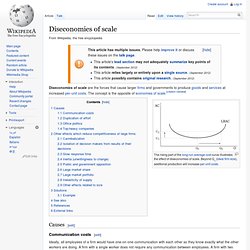
A firm with a single worker does not require any communication between employees. A firm with two workers requires one communication channel, directly between those two workers. Theory X and theory Y. Theory X and Theory Y are theories of human motivation created and developed by Douglas McGregor at the MIT Sloan School of Management in the 1960s that have been used in human resource management, organizational behavior, organizational communication and organizational development.
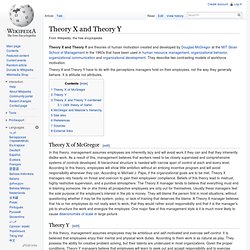
They describe two contrasting models of workforce motivation. Theory X and Theory Y have to do with the perceptions managers hold on their employees, not the way they generally behave. It is attitude not attributes. Peter Principle. An illustration visualizing the Peter principle The Peter Principle is a concept in management theory in which the selection of a candidate for a position is based on the candidate's performance in his or her current role rather than on abilities relevant to the intended role.

Thus, employees only stop being promoted once they can no longer perform effectively, and "managers rise to the level of their incompetence. " The principle is named after Laurence J. Peter who co-authored with Raymond Hull the humorous 1969 book The Peter Principle: Why Things Always Go Wrong. Overview[edit] The Peter Principle is a special case of a ubiquitous observation: Anything that works will be used in progressively more challenging applications until it fails. Peter suggests that "[i]n time, every post tends to be occupied by an employee who is incompetent to carry out its duties"[2] and that "work is accomplished by those employees who have not yet reached their level of incompetence. " William Whyte's The Organization Man. Edgar Schein. Edgar Henry Schein (born March 5, 1928), a former professor at the MIT Sloan School of Management, has made a notable mark on the field of organizational development in many areas, including career development, group process consultation, and organizational culture.
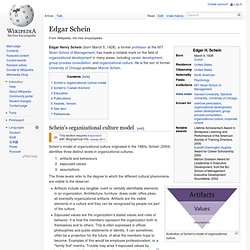
He is the son of former University of Chicago professor Marcel Schein. Schein's organizational culture model[edit] Illustration of Schein's model of organizational culture Schein's model of organizational culture originated in the 1980s. Schein (2004) identifies three distinct levels in organizational cultures: artifacts and behavioursespoused valuesassumptions The three levels refer to the degree to which the different cultural phenomena are visible to the observer. Artifacts include any tangible, overt or verbally identifiable elements in an organization. Schein's 'Career Anchors'[edit] A 2008 study distinguishes between entrepreneurship and creativity to form nine possible constructs.[4] Education[edit]
Coercive persuasion. Mind control (also known as brainwashing, coercive persuasion, thought control, or thought reform) is an indoctrination process which results in "an impairment of autonomy, an inability to think independently, and a disruption of beliefs and affiliations.
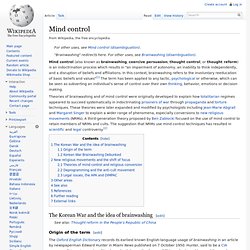
In this context, brainwashing refers to the involuntary reeducation of basic beliefs and values"[1] The term has been applied to any tactic, psychological or otherwise, which can be seen as subverting an individual's sense of control over their own thinking, behavior, emotions or decision making. Theories of brainwashing and of mind control were originally developed to explain how totalitarian regimes appeared to succeed systematically in indoctrinating prisoners of war through propaganda and torture techniques.
These theories were later expanded and modified by psychologists including Jean-Marie Abgrall and Margaret Singer to explain a wider range of phenomena, especially conversions to new religious movements (NRMs). Parkinson's Law. UK First edition book cover Originally, Parkinson's law is the adage that "work expands so as to fill the time available for its completion", and the title of a book which made it well-known.

However, in current understanding, Parkinson's law is a reference to the self-satisfying uncontrolled growth of the bureaucratic apparatus in an organization. History[edit] Articulated by Cyril Northcote Parkinson as part of the first sentence of a humorous essay published in The Economist in 1955 and since republished online,[1][2] it was reprinted with other essays in the book Parkinson's Law: The Pursuit of Progress (London, John Murray, 1958).
He derived the dictum from his extensive experience in the British Civil Service. W. Edwards Deming. William Edwards Deming (October 14, 1900 – December 20, 1993) was an American engineer, statistician, professor, author, lecturer, and management consultant.
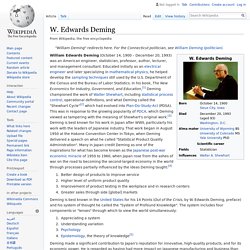
Educated initially as an electrical engineer and later specializing in mathematical physics, he helped develop the sampling techniques still used by the U.S.